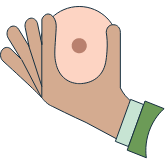

No matter how you hold your baby while breastfeeding, it’s important to get a good latch. A good latch will help you feel comfortable and allow your baby to get the most milk.
Create a calm environment
Breastfeeding will be easier when you and your baby are relaxed and calm. Find a comfortable chair and position where you feel safe and supported. Try playing some soft, calming music.
Hold your baby skin-to-skin
Hold your baby, wearing only a diaper, against your bare chest. Hold the baby upright between your breasts, and just enjoy your baby for a while with no thoughts of breastfeeding.
Let your baby lead
One way to get your baby to latch is to let them lead and follow their natural instincts to suck. Allowing your baby to search for the breast can take some of the pressure off you and help keep your baby calm and relaxed. If your baby is not hungry, they will stay curled up against your chest. If they are hungry, your baby will bob their head against you, try to make eye contact, and squirm around.
Support and help your baby, but don’t force the latch
Your baby may need help latching at first. Use one arm to support your baby’s head and shoulders as they search for your breast. Use your other arm to support your breast by using a C hold or U hold. When your baby’s chin hits your breast, the firm pressure will make them open their mouth wide and up over the nipple.
As they press their chin into the breast and open their mouth, they should get a deep latch. When your baby has a good latch, they can breathe at your breast and their nostrils will flare to allow air in. Check to make sure your baby’s nostrils are not blocked by your breast.




Tickle the baby’s lips to encourage them to open wide.

Pull your baby close so that the chin and lower jaw moves into your breast first.

Watch the lower lip and aim it as far from the base of the nipple as possible, so the baby takes a large mouthful of breast.

Tickle the baby’s lips to encourage them to open wide.

Pull your baby close so that the chin and lower jaw moves into your breast first.

Watch the lower lip and aim it as far from the base of the nipple as possible, so the baby takes a large mouthful of breast.
Side-Lying Hold
This hold is useful when:
Cross-Cradle Hold
This hold is useful when:
Clutch or “Football” Hold
This hold is useful when:
Cradle Hold
This hold is useful when:
Laid-Back Hold
This hold is useful when: